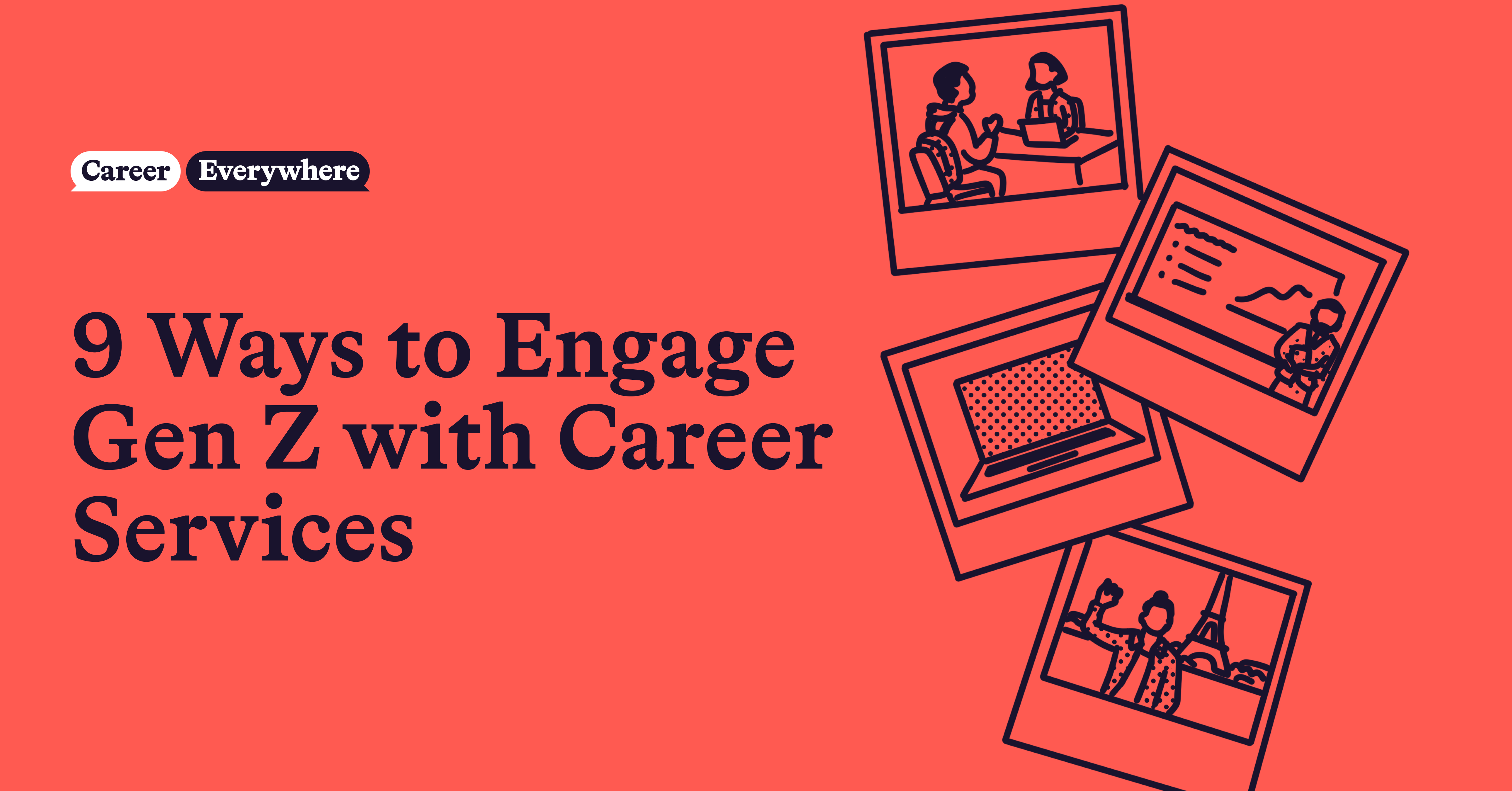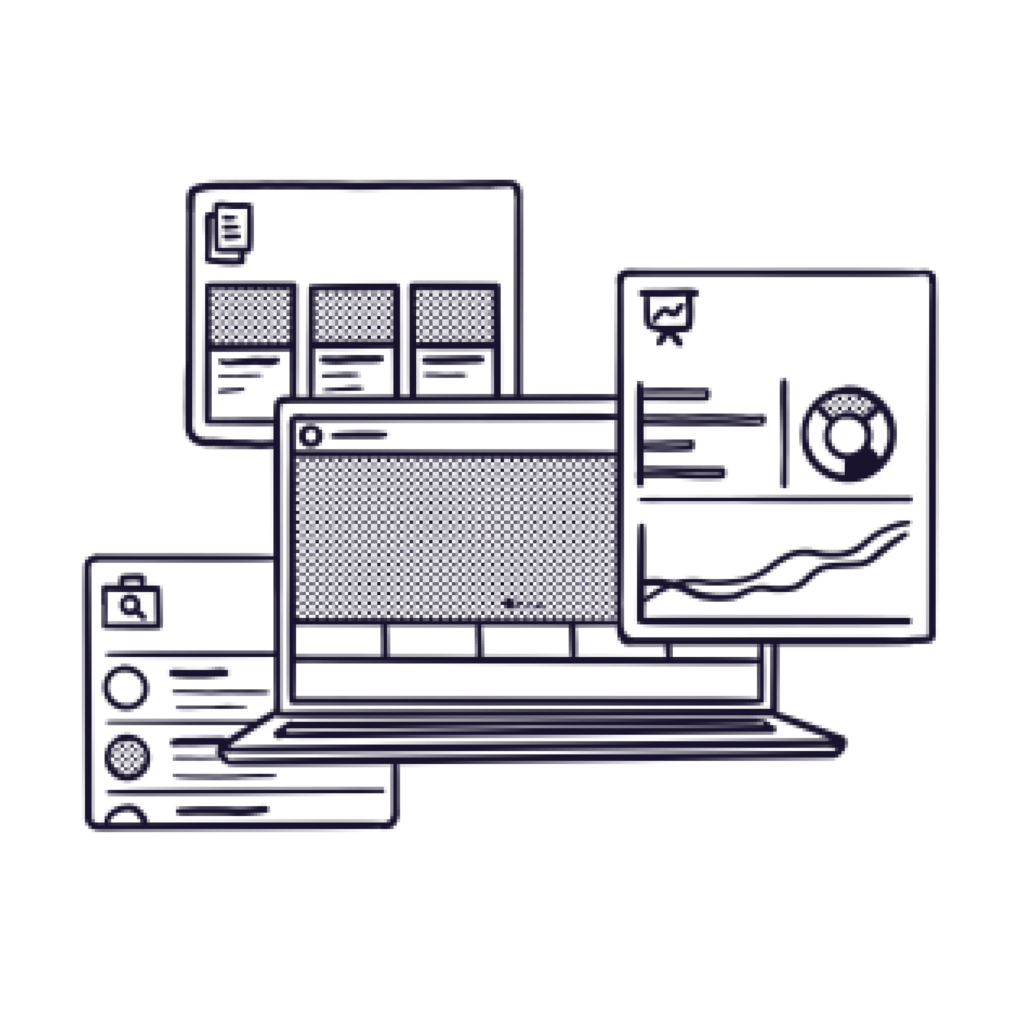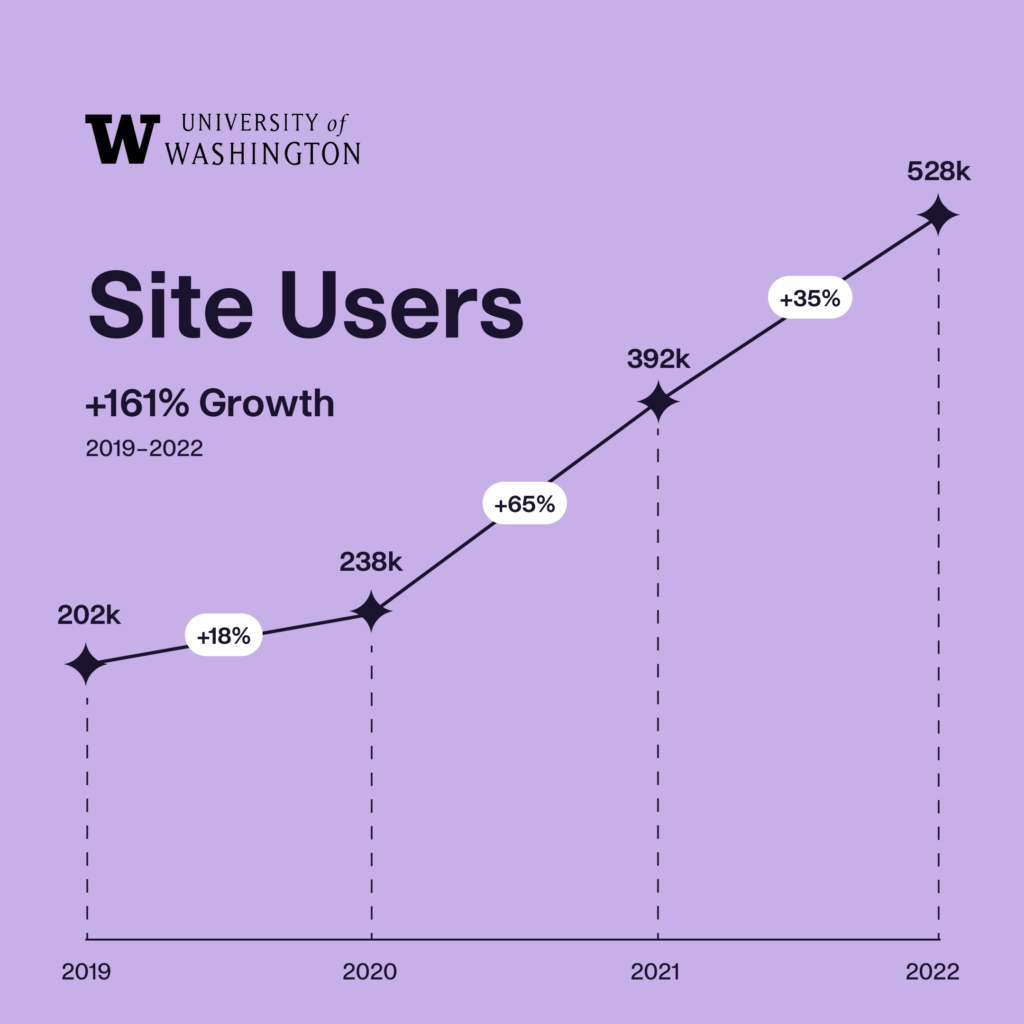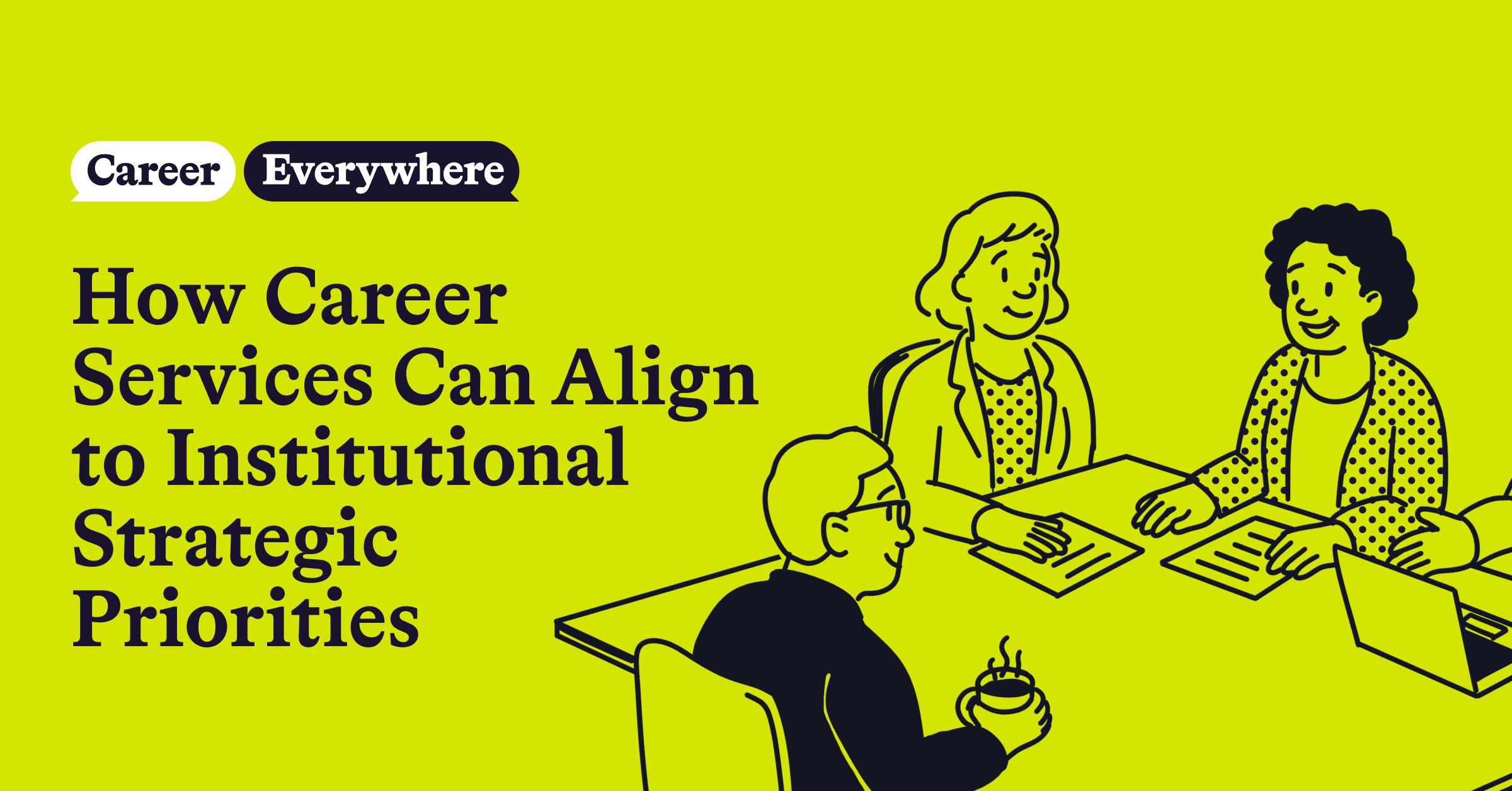
The career services evolution in higher education has been underway for some time now, with career centers nationwide making big changes to the way they approach student engagement.
A big part of that, as we know, is the pressure of the ROI conversation around higher education. What career outcomes can students expect from their investment in a college degree?
But another major element is the generational shift on campus, with Gen Z students (and soon, Gen Alpha) making up the core student population. And with Gen Z’s rise in post-secondary enrollment comes an entirely new demand for career resources, programming, and the way that content is packaged and delivered.
In short, the traditional way of doing things in career services (e.g. relying on students to come into the physical career center or presentations to classes) simply does not cut it anymore. Gen Z demands a more modern, curated, personalized approach—and any career center that can’t adapt and offer that will quickly become obsolete.
The good news? There is a ton of innovation happening in the career services field right now, with hundreds of institutions trying new strategies, finding success, and increasing student engagement in a time where getting the attention of 18-to 22-year-olds might feel impossible.
In this article, we’ll walk through 10 of those innovative approaches and include examples from the career services teams who are implementing them.
Who is Gen Z?
Before we get into those strategies, let’s quickly define who Gen Z is. While it’s not necessarily fair to generalize an entire generation, there are some widely accepted similarities among Gen Z students that provide important context for career services teams.
According to the Pew Research Center, Gen Z encompasses individuals born during and after 1997. This generation is entering the workforce, with the oldest members having around five years of professional experience.
Here are a few common characteristics, values, and strengths of Gen Z:
- They are digital natives, very tech-savvy, and the first generation to grow up with the internet, social media, and smartphones from a young age.
- Gen Z is highly value-centric, particularly around environmental sustainability, social responsibility, and ethical practices.
- They are curious and continuously eager to learn, with a strong desire for self-improvement.
- Gen Z values open and honest communication. They prefer straightforward interactions and are often very clear about their expectations and feedback from peers, supervisors, and other individuals in the workplace.
- Gen Z is generally more considerate of diversity and inclusion issues, advocating for spaces that respect and embrace differences.
Learn more about how career services can prepare Gen Z for the world of work in this article.
10 ways to engage Gen Z with career services
Now that we have some context on who Gen Z is and what they respond to, let’s dig into the innovative strategies modern career centers are using to engage them.
1. Curate career resources into a digital one-stop-shop
As we mentioned above, Gen Z are digital natives through and through. They’ve grown up engaging with content, education, media, and more in digital, virtual environments—most of which involve algorithms that curate content based on their interests and are available on-demand 24/7.
Knowing this, more and more career centers are investing in their “virtual front door” (aka their websites) to make them a modern, sleek, one-stop-shop for career resources. Because let’s face it, the minute a Gen Z student sees an outdated career website with stale content, bad design, and difficult-to-find resources, they’ll be significantly less likely to seek support from the career center and assume they’re out of touch with the modern workplace.
That first impression really, really matters to Gen Z.

And it’s not just about the design of the website, it’s about the functionality. To truly be a one-stop shop, you can’t merely link to all of your career resources in different places across your website. Instead, your site should be directly serving up the content that actually lives within each of those resources/tools in curated spaces that will resonate with students. That curation is what Gen Z has come to expect elsewhere, so it makes sense to set up your “virtual front door” in the same way if you want Gen Z to actually use it.
Here are a few examples of career centers that have executed this one-stop shop concept particularly well. Note: All of these sites are built on uConnect’s virtual career center platform, which specializes in the consolidation and curation of career resources.
- University of Washington Career and Internship Center (Notice their use of career interest and identity/affinity community pages to curate resources even further)
- University of Florida Career Connections Center (Note how UF’s career community pages pull in dozens of resources—job market data, LinkedIn Learning courses, alumni mentors, virtual job simulations—all personalized to each specific community)
- University of Kentucky Gatton College of Business and Economics Graham Office of Career Management (Students can find articles, jobs and internships in Handshake, videos, upcoming events, job market insights, mentors through ADPList, and more—all in one place with just a few clicks)

These virtual career centers (at least, that’s what we call them because they’re so much more than “just a website”) not only make a better first impression on Gen Z students, but they’re also proven to increase student engagement.
For example, the University of Washington has seen a 533% increase in community page views since launching their communities, and they saw a 161% increase in total site users from 2019-2022.
The University of Oregon Lundquist College of Business has also seen an impressive increase in engagement since launching their virtual career center (powered by uConnect). From January 2022 to January 2023, they saw a 798% increase in page views on their virtual career center.
2. Invest in video content
Unsurprisingly, video is the No. 1 format for content consumption among Gen Z. But did you know that 91% of Gen Z students prefer watching videos for learning purposes? This makes it critical for career teams to support and engage students with video content to meet students where they’re at.
But what kind of video content? What format, style, and length? Where do you share and distribute those videos? Who should create them and/or appear in them?
Willie Wittezehler, Creative Director and longtime professional road tripper/interviewer/producer with Roadtrip Nation, shared in a recent webinar with uConnect a few key things to consider when leveraging video content to engage Gen Z:
1. Prioritize authenticity
Gen Z prefers authentic content and can quickly discern authenticity from filtered or edited highly content. (In short, they have very tuned BS radars and know when they are being marketed to). To appeal to this audience, it’s crucial to create videos that showcase real representations of shared identities, values, and interests. For example, Roadtrip Nation has seen success in this area by conducting video interviews with professionals who have turned their interests into careers, providing relatable and inspiring stories for young viewers.
2. Balance short-form and long-form video content
Gen Z is known for having short attention spans, making it essential to create engaging short-form content to capture their interest. However, Wittezehler notes that long-form video content can also be successful with young people, particularly on platforms with live stream functions where viewers are willing to deep dive into niche interests. The key is to use short-form content as a hook to draw viewers in and then provide them with the option to explore more in-depth content based on their interests.
3. Leverage social media platforms for distribution
Young people consume video content across a variety of social media platforms, each with its own unique user behaviors and preferences. To effectively reach Gen Z, career services teams should create content tailored for each platform. For example, Roadtrip Nation uses Instagram Stories and YouTube shorts to capture attention and direct viewers to longer videos, such as day-in-the-life content and full-length interviews. Wittezehler also highlights the importance of leveraging influencers and micro-influencers who can organically deliver messages to the target audience on their preferred platforms.
4. Carefully consider your host/on-camera talent
Having a relatable and engaging host is crucial for building trust and developing a parasocial relationship with young viewers, especially on social media platforms like YouTube. Wittezehler emphasizes the importance of humanizing the messenger in videos, as Gen Z wants to see and feel a sense of trust, relatability, and inspiration from the person delivering the message. A compelling host can help balance the sharing of career information with inspiration and motivation, keeping viewers engaged throughout the content.
5. Encourage and empower user-generated content
For career teams with limited marketing and communication support, Wittezehler suggests empowering Gen Z to create content themselves. This could be accomplished by leveraging student interns and ambassadors. By providing young people with the tools and guidance to share their own stories and experiences, career services can tap into the authenticity and relatability that Gen Z craves. This approach not only helps to create more engaging content but also fosters a sense of community and belonging among students.
3. Regularly publish student stories on your website
Like we mentioned in the video section above, Gen Z really cares about the messenger and authenticity when it comes to career-related content. And again, leveraging user-generated content is a great way to deliver relevant content that Gen Z students will like and trust.
After all, who better to explain the Gen Z career experience than Gen Z’ers themselves?
That was the mentality of the University of Pennsylvania career services team and their Senior Associate Director of Communications and Technology Michael DeAngelis when they created their summer grant funding program (and associated blog).
Essentially, Penn provides summer funding grants to students who need financial help for summer internships, volunteering, research, and other opportunities. In addition to helping award those grants, DeAngelis and his team also ask every student recipient to provide a blog post about their internship or other experience. After funding over 150 students last year, the Penn Career Services team had enough blog content to last them an entire year.
“We know students like hearing from their peers. We know students love seeing their peers highlighted. And it’s really great to get the first-person perspective. So these blogs are great advertising to let people know that we have this funding, and here’s an example of someone who got it,” DeAngelis said.
“It gives people a great view of all the different things that Penn students do, all the different industries they work in, all the different research experiences that they have, all the different volunteer experiences that they have. It just shows the diversity of opportunities that are available and that are pursued.”
4. Build community pages on your website
We know Gen Z vastly prefers curated, personalized content. All you have to do is look at the way they consume content on social media, streaming platforms, YouTube, etc.
That’s why so many career services teams are upgrading their websites to include community pages based on career interests and identity/affinity. Each of these community pages includes articles, videos, events, job and internship postings, virtual job simulations, LinkedIn Learning courses, alumni mentors, and more—and they’re all curated based on the theme of that community page.
Here are a few examples:
- First-generation students (University of Washington)
- Alaska Native and Indigenous students (University of Alaska Southeast)
- Healthcare and Health Sciences careers (University of Florida)
- Business careers (Washington University in St. Louis)
- LGBTQ+ students (University of Connecticut)
- Parents and families page (Arcadia University)
Community pages make it so much easier for students to find career resources that are relevant to them, and they allow them to feel seen and represented in the career center’s offerings—both of which are highly valued by Gen Z.
5. Embed career into the classroom
We know faculty can be a career team’s biggest allies (and their biggest challenge sometimes), and classrooms are a great way to reach a lot of Gen Z students in a short amount of time.
That’s why so many career centers prioritize finding ways to embed career in the classroom, whether it’s through in-class presentations, adding career language to syllabi, collaborating with faculty to include career-related assignments and resources in their curriculum, and more.
Here are a few examples of career teams who have done exactly this:
1. University of Kentucky Gatton College of Business and Economics
The Graham Office of Career Management in UK’s business school offers a career-development course called the Gatton Pro Series—or GPS for short—as part of their four-pronged approach to career services: Graham in the Office, Graham in the Classroom, Graham Virtually, and Graham Away.
The Gatton Pro Series is a three-course curriculum designed to teach students how to navigate the college-to-career readiness journey. These courses include:
- Professional Leadership Development
- Professional Exploration and Career Management
- Strategic Business and Professional Communication
Since the Graham team recently revamped GPS, student enrollment in the classes has increased by 380%, and 99% of Gatton students enrolled in GPS courses in 2022-2023 said they would highly recommend the GPS to other Gatton students.
Learn more about how the Graham team engages Gen Z students with career services in this podcast episode.
2. University of Arizona Global Campus
The University of Arizona Global Campus career team serves a lot of adult learners (so not necessarily Gen Z), but their strategy of embedding career-related videos into curriculum is one that could easily be applied to career centers serving a more traditional student population.
In short, Matt Phlllips and Rebecca Davis of UAGC work closely with faculty to embed Candid Career+ videos and recorded employer information sessions into online courses (including in assignments and in UAGC’s learning management platform Canvas).
“I collaborate with faculty to do everything from help them curate videos to build playlists for specific programs of study, and even craft the assignments alongside them. So our learners are always looking for, I don’t want to call it bite size, but very impactful content in three to five minutes that they can spring off into any readings they need to do, into any reflective writings they need to do,” Phillips said.
3. University of Oregon Lundquist College of Business
To engage more students with career services (and earlier in their college careers), the University of Oregon Lundquist College of Business career center partners with faculty to add career-related assignments to three core business classes.
The assignments, all asynchronous and requiring no live class time, are sprinkled throughout:
- BA 101: Introduction to Business (a freshmen-level class)
- BA 240: Spreadsheet Analysis and Visualization (a sophomore-level class)
- Marketing 311: Marketing Management (an upper-division class)
That way, by the time business students reach their senior year, they’ve already been exposed to career multiple times. And because the assignments are part of their grade in three required classes, every student gets the opportunity to learn more about the career center and what resources are available.
“It’s a way for us to signal as a college that we feel this is so essential to your education that we are embedding it into these core classes and assigning points to it. We’re using the incentive that we have trained them to cue into, which is points in a class,” says Jessica Best, Director of Career Strategy for Mohr Career Services. “We can ensure everybody at least has equal access to it and then they can make the choice whether they want to engage or not.”
Best says about 90% of students engage with the career assignments, and her team frequently surveys the students to get their feedback on the program and track their progress.
Learn more about how the Mohr Career Services team embeds career into curriculum in this podcast episode.
6. Offer unique, out-of-the-box programming on campus
A little out-of-the-box thinking never hurts, especially when you’re trying to break through the noise and get the attention of Gen Z students through your resources and programming. Something different than (and in addition to) the standard resume review sessions, employer presentations, career fair prep workshops, etc.
Here are a few examples:
1. Improv for Interviewing workshop at the University of Pennsylvania
Michael DeAngelis, the Senior Associate Director of Communications and Technology at the University of Pennsylvania, launched a popular 90-minute Improv for Interviewing workshop for Penn students in 2020.
A former theater major, actor, published playwright, and accomplished podcaster, DeAngelis uses games and techniques from the theater world to help students think on their feet and keep the conversation going.
Because as Michael says, “What is an interview anyway, but a conversation?”
2. The Professional Advantage Academy at PennWest
Applying for jobs, internships, and grad schools can be intimidating, which is why students often turn to career services for help with the process. But no career center has the capacity to meet 1:1 with every student who needs a resume review, interview prep, help with their cover letter, etc.
That’s why Pennsylvania Western University built a five-week course, called the Professional Advantage Academy, that simulates the job application process. Josh Domitrovich, the Interim Associate Vice President for Student Success at PennWest, said the course fully mimics the job application and interview process.
Students learn to identify and articulate their skills and experience; write resumes and cover letters; apply to jobs, internships, or grad schools; answer interview questions; and more.
3. HireU 2.0 at the Wake Forest University School of Business
Cheryl Rotyliano, Senior Associate Director of Market Readiness and Employment at the Wake Forest University School of Business, recently launched an ATS (applicant tracking system) simulation program she developed to demystify the recruiter experience for students.
The program (called HireU 2.0) involves a one-hour simulation where students work together to review resumes, cover letters, and video interviews to make hiring decisions. The simulation helps students understand how applicant tracking systems work and empathize with the challenges that modern recruiters face.
7. Develop an on-campus internship program
Not every Gen Z student has the opportunity to pursue an off-campus internship, whether that’s due to budget constraints, family responsibilities, lack of transportation, lack of housing, or something else.
For students at St. Lawrence University in rural upstate New York, internship opportunities are hard to come by. That’s why Sarah Coburn, Senior Associate Director for Experiential Learning and Employer Engagement at St. Lawrence University, built the institution’s highly successful on-campus internship program (OCIP).
OCIP provides paid internships for students to work in various departments on campus, gaining valuable skills and experience. The internships are structured to include additional professional development time and orientation (also paid) through the career center.
Sarah built partnerships with nearly 20 departments across campus to structure the internships so students gain valuable experience and skills, earn a paycheck, and have their performance measured and monitored in a standardized way.
Learn more about how Coburn built (and plans to grow) OCIP in this podcast episode.
8. Prioritize your social media presence (and other media)
Gen Z students are exceptionally media savvy and make heavy use of a variety of social media platforms to consume content and search for information. To meet those Gen Z students where they are, career services teams need to invest in their social media presence—and other media endeavors.
For example, the Graham Office of Career Management at the University of Kentucky Gatton College of Business and Economics has spent the last year beefing up its LinkedIn page. With nearly 1,000 followers, the page has become known for its clever, regular posts that communicate important career information to students.
Check out this recent Pitch Perfect-themed post about mastering your elevator pitch.
At the Indiana University Kelley School of Business, the career services team hosts a weekly Instagram Live session called #WednesdayWisdom Unfiltered Career Search that they then convert into a podcast.
Speaking of podcasts, many other career centers also produce their own podcasts to, again, try to meet their Gen Z students where they are (and at any time). Here are a few examples:
- University of Pennsylvania: CS Radio
- Denison University: DUing Cool Things
- Columbia University School of Professional Studies: Rising to the Top
- Yale University: Craft & Career
- Duke University: What’s Career Got To Do With It?
- University of Kentucky Gatton College of Business and Economics: The Graham Scheme of Things
9. Offer real-world data to help Gen Z with career exploration
With the cost of higher education continuing to rise, Gen Z students are, understandably, very concerned about the ROI of their investment in a college degree. They know the stakes are high and want to go into the career exploration process with their eyes wide open and with the most up-to-date information available.
To address this need, hundreds of career centers nationwide offer labor market insights on their virtual career centers. This type of data can show job market projections, compensation ranges, most in-demand skills, degree requirements, top employers, top locations, and more for any occupation.
Dave Merry, Associate Provost and Executive Director of the Center for Career Equity, Development, and Success at Suffolk University, says the Labor Market Insights module (powered by uConnect) helps his team improve career equity for their students. See what it looks like on their website here.
Amanda Morgan, Associate Director of Career Services for the Academic Success and Career Center at Washington State University, and her career team also use labor market insights and regularly train academic advisors across campus to use the data, too. That way, more students (regardless of background or circumstance) have the information they need to explore careers and plan their academic pathways.
For more information on how to use labor market insights in your career center, check out this article.
Conclusion
While it can certainly be challenging to reach Gen Z students and hold their attention, career services teams across the country are finding clever, innovative ways to do exactly that.
From investing in a virtual career center and putting all their resources in one place, to investing in video, launching podcasts, developing out-of-the-box programming, and more, the career services teams actively working to evolve their offerings are seeing drastically increased engagement rates among Gen Z students.
To stay in the loop about the latest innovations in career services (and brainstorm with your peers), join 1,200+ career leaders in the free Career Everywhere community.


